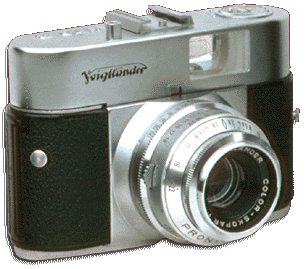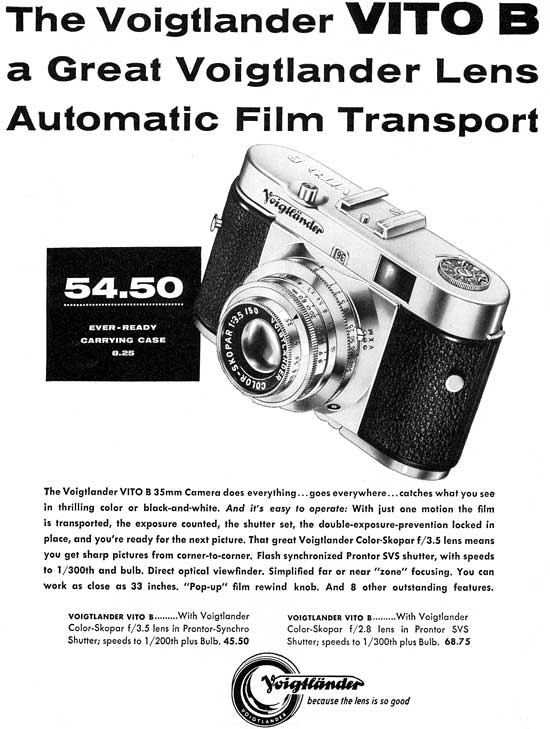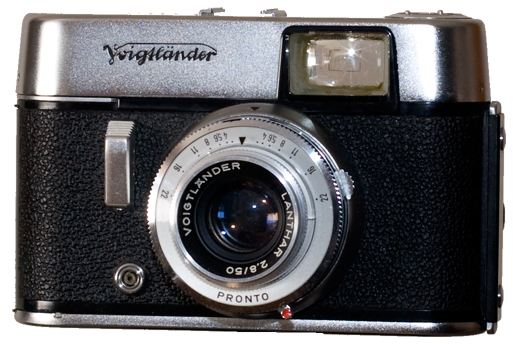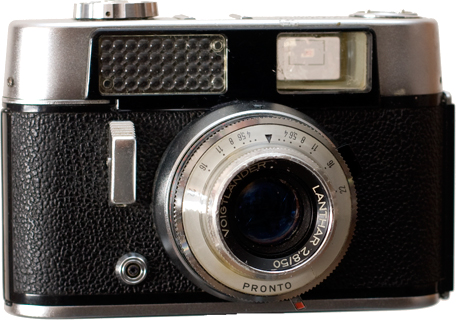
Approx. dates of manufacture: B: 1954 - 1961
C: 1960 - 1968
CD: 1960
Approx. original price: Around $30-$75, depending on the year and various options
Approx. street value: low-moderate, depending on condition and greed
I keep adding cameras to this page because I keep getting Voigtländers that don't really rate separate pages. In the late 50s and 60s, Voigtländer was run by Zeiss and caught Zeiss Fever, a burning desire to take a basic camera and market a dozen variations on it. Features, lenses, and finishes were mixed and matched.
The point is that there's more than the typical family resemblance between most of these cameras. Enough that I didn't feel they rated separate pages, but ought to go together.
I was at the local swap meet one day when I saw this Voigtländer Vito B sitting on the table. The viewfinder glass was broken, and the guy was selling it for $15. I'd never seen one before, but the price was right and it looked beautiful otherwise, so I bought it. The guy told me it was a fantastic camera, and that I got a helluva deal. Yeah, right: they all say that.

It was easily fixed. The viewfinder turned out to be a solid piece block of glass and the glue holding it in place had turned to dust. So it was just a matter of cleaning it a little and gluing it back down. When it was ready, I fiddled with it to figure out how it worked and then ran a roll of film through it.
WOW. I've never been blown away by images from a camera before, but I did with this one. Part of it is that I used slow film and I develop for high acutance, which always looks nice, but the optics on that camera are just wonderful. I only used it a few times but I always got wonderfully sharp images from it. The guy was right—it's a helluva camera.
That's about all it did. There was no meter on it at all, so the photographer either has to use a hand-held meter or just guess. Technically it isn't even a rangefinder, since there is no ranging to it (a rangefinder is the mechanism that produces that "ghost" image in the viewfinder: when the main image and the ghost match up, the range is found and the lens is set to the proper distance). The viewfinder, as a consequence, is incredibly open and very bright.
It's European, so it's quirky as hell. To open the back you have to pivot a little lever on the bottom of the camera and twist it; this opens a door on the bottom of the camera which allows the back to swing open. Loading the film can be a pain, since if the metal cartridge isn't just right, the bottom won't seat properly and you can't get the thing closed. The likelihood of not being able to close the camera varies geometrically with how quickly you need it to be done.
 Other goofiness includes the count-down exposure indicator, a locking aperture ring: you have to squeeze the buttons to turn the ring to
set the aperture: but the great thing is that if you set the shutter/aperture combo once, you can lock in that combination; so if you
decide you want a faster shutter speed, you turn the shutter speed and the aperture automatically turns with it, so you don't have to
reset it to compensate. And the film advance lever is located on the back of the camera, not the top, which puts your thumb in the way
if you are (like me) looking through the viewfinder with your left eye. But these are quibbles. It's a great camera.
Other goofiness includes the count-down exposure indicator, a locking aperture ring: you have to squeeze the buttons to turn the ring to
set the aperture: but the great thing is that if you set the shutter/aperture combo once, you can lock in that combination; so if you
decide you want a faster shutter speed, you turn the shutter speed and the aperture automatically turns with it, so you don't have to
reset it to compensate. And the film advance lever is located on the back of the camera, not the top, which puts your thumb in the way
if you are (like me) looking through the viewfinder with your left eye. But these are quibbles. It's a great camera.
I don't want to oversell this because I don't get much email from this site, but I've gotten more comments from people who praise the Vito B than I have about any other camera, good, bad or indifferent.
The Vito C is very similar, though it obviously benefitted from feedback on the B's. The shutter trigger is now on the front of the camera body instead of the top, though the film-advance lever is still on the back. There's still no rangefinder and no meter, but there's a self timer lever. The aperture/shutter lock is gone. And the lens is different. My Vito B has a ƒ/3.5 Color Skopar, my Vito C is an ƒ/2.8 Lanthar. According to Per Friis, a Lanthar is a 3-element lens and a Skopar is a more-desirable 4-element (they also made a 6-element Ultron). The Color-Skopar was an updating of the Skopar formula.
 My Vito CD is the same as the Vito C but it has a selenium meter added to the top of the camera. Selenium cells are great because they don't need batteries to run, they get their juice from the light that strikes it.
My Vito CD is the same as the Vito C but it has a selenium meter added to the top of the camera. Selenium cells are great because they don't need batteries to run, they get their juice from the light that strikes it.
I've run film through one or both of these cameras (I don't remember which anymore) but never got the results I did with the Vito B.
Camera manual: Orphan Cameras.com



